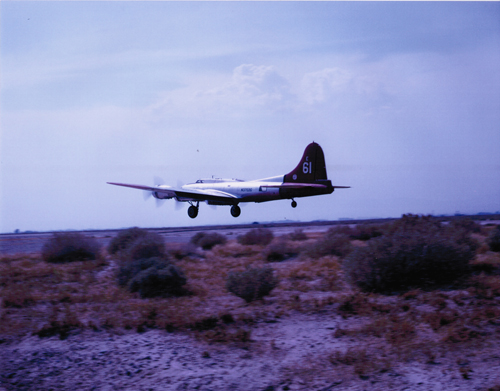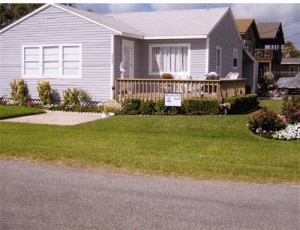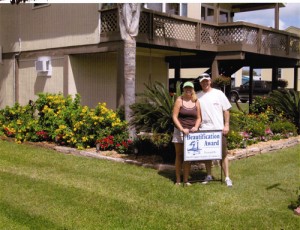
Larry Wegeman (right) of Port O’Connor with Captain Hill and Tanker 61, a Flying Fortress owned and operated by TBM, Inc., Tulare, CA 1967-1979; on static display USAF Museum, Castle AFB, CA 1979-2002.
The G Model was the last in the series of B-17s produced by Boeing, but not all G Models saw combat action during World War II.
In addition to main and auxiliary tanks, six small fuel cells crowded each wingtip. Although nicknamed Tokyo tanks to dramatically illustrate the additional range, it was an exaggeration to think that any Flying Fortress had the range to bomb Tokyo from any base during the war. Perhaps the nickname boosted the morale of airmen or was intended to give the Japanese concern. Albeit, the B-17G was definitely designed for longer range bombing – but not Tokyo.
By the close of the air war in Europe, B-17s were ranging 1,000 miles from England, hauling a six thousand pound bomb load. Meanwhile in the Pacific, the B-29s routinely bombed Japan from Guam – a distance of 1,500 miles, with bomb loads of twenty thousand pounds. The B-29 was larger and more advanced; built to haul more bombs greater distances.
With the surrender of Germany in May 1945, production of Flying Fortresses ceased. Fighting men and some machines moved to the Pacific theater to join the fight against Japan – but not the B-17s. Some were distributed to America’s allies. Others played non-combative rolls as observation aircraft and for use by the US Coast Guard, but most returned to the states to be scrapped. A few were mothballed to the bone yard at Davis-Monthan Air Force Base in Tucson, AZ.
Twenty-two years after the war, TBM Incorporated of Tulare, CA purchased three such B-17Gs from the bone yard – at a cost of one dollar each. Two Flying Fortresses would go into service, the third was used for spare parts.
TBM Inc. was in the firefighting business and took the company name from Grumman’s famous Torpedo Bomber (Medium) TBF Avenger and actually operated a few of these aircraft as firefighters. A TBM carried 6,000 lbs. of fire retardant.
Twenty-eight years after the war – during the fire season of 1973, I knew the Flying Fortresses (photo below) as Tanker 61 or 02G – the call sign used for talking to ground control or the control tower. The aircraft’s log indicated that 02G had never left the states. She was an honest bird, crossed the fence at ninety, stalled at sixty-five, and coughed fire n’ smoke as each radial engine ignited the cool California morning.
Stationed at William Fox Field in Lancaster for firefighting duty, Tanker 61 was number one to respond to a fire anywhere in the Angeles Forest. However, late one September morning, duty called her elsewhere.
One-by-one, each radial engine ignited the cool morning air. High-octane exhaust fumes tricked into the cockpit, until the sound of four 1,200 horsepower Pratt and Whitney 1820/97s engines resonated as one synchronized voice. The silent, metal form of the Flying Fortress had come to life.
The engines revved.
Slowly, she began to roll.
The load was on the way.
I scrambled to raise either ground control or the control tower as the threshold of the 5,000-foot runway drew closer. The tower should be answering, but regardless, Captain Hill was not waiting.
Slowly and with a purpose, the determined B-17G headed to the runway, rolling along hundreds of feet of lonely tarmac – the only movement anywhere on William Fox Field. At the end of the taxiway and with a smooth, broad turn, the outer engine swung the Flying Fortress a full one hundred eighty degrees onto the concrete runway. I scanned the sky for incoming traffic, then keyed the microphone, “This is 02Gulf – clear to take-off.”
Captain Hill affirmed with a nod, but the tower remained silent.
The turning slowed as the wide, white runway line straightened out in front of us. The throttles went forward, the powerful engines roared.
Captain Hill threw a sarcastic look at the tower as the tail wheel lifted. Then he smiled.
“I tried all the frequencies.”
“You did the right thing, Wegeman. Maybe they’re asleep,” smiling again.
The main wheels of the Flying Fortress lifted-off just as the fast moving desert shrubs swished under the nose. With the wings level, the bird would do the best rate of climb – but wait before banking this close to the ground, carrying a low airspeed and a full load, while the turbo-charged engines labor to lift the 60,000 lbs. at barely a hundred feet per minute.
Captain Hill’s thumb rose. I pulled up the gear. Without the wheels obstructing the oncoming air, she would climb faster – and as airspeed increased, faster yet. A quick look from the right window revealed the gear slowly cranking. He watched the left where the pilot sat. I was the co-pilot. A green light illuminated above the landing gear switch, indicating the gear up – but not a reliable gauge.
Each pilot faced a control wheel, with brakes and rudder under foot, and a console in-between. In front of me was the landing-gear lever; shaped like a miniature wheel that had to be pulled before lifted. To the extreme right were four engine-starting switches and to the left fuel gauges and a row of four-drop switches. A drop-down cover guarded each drop switch that had to be lifted before the drop switch could be activated. Rising from the console were three separate levers for each of four engines, built close to allow easy synchronization. A skilled pilot could handle all twelve controls with the heel and fingers of one hand.
A maze of gauges glowed from the instrument panel, each in duplicate, describing each engine’s exhaust-gas temperature, oil pressure, manifold pressure, and engine RPM (that’s 32 gauges). Additionally, navigation and air speed, needle and ball, gyros, along with altimeter and rate of climb indicators round the array.
The Flying Fortress was still laboring to climb, now at 300 feet per minute.
Radios and a transponder were centrally positioned for either pilot to access. The fuel gauges were noted as unreliable. An accurate reading could only be had after landing, by climbing onto the wing and dipping each tank. Fuel consumption was figured by time-on-the-Hobbs Meter or time-in-the-sky. Only the mains were used, not the auxiliary or Tokyo tanks. This enabled carrying a larger load of fire retardant, and the Forest Service liked that.
On the console with the engine controls were four cowl flap activators. The cowl flags were located around the cowling of each radial engine and opened to cool the engine. The four activators kept the cowl flaps closed on take-off but opened manually once the airplane touched down for landing.
As the Flying Fortress labored in a southerly direction, a flume of dark smoke appeared on the horizon. “You take it, Wegeman. I’m going below.”
Captain Hill swung from the seat and pointed. “Head for that smoke. Keep it at five thousand.”
The Captain climbed and shaved. Reporters would be covering the fire, and the Flying Fortress always got the attention.
The fire had been raging for days, and as it grew, more and more air tankers were called from surrounding areas. In the days before Tanker 61 was called, we reviewed fire-news broadcasts over Forest Service frequencies. Hemet-Ryan was the airport for reloading and overnight parking. Tankers flew from sun-up to dusk, and for the duration of the fire the airport would be closed to private air traffic.
Weather conditions were important, especially wind. The needed radio frequencies were ATIS (Automatic Terminal Information Service – now operated by the Forest Service) and the birddog pilot, Lou Rossi. There was no tower at Hemet-Ryan.
As the smoke grew closer, we listed for chatter between Lou Rossi and the various tankers. His job was to lead on every drop, and we were beginning to get a picture of the fire plan. The general idea was to build a firebreak; a solid line of red Phos-chek, which in theory would stop the fire by separating it from the unburned timber.
Tankers arriving from the firebase rendezvoused in a circle upwind of the fire. Tankers entered on top and only two tankers in the circle – one high and one low. As Lou Rossi dispatched a tanker from the lower altitude, the other tanker dropped down and the next tanker entered. When a tanker departed the circle, Lou was right there to guide, and Lou did all the talking. “See the fire break? Extend it! Watch the wind and smoke; keep seventy-five feet from the ground and remember to peel-up to the left.”
“Okay, Lou,” was the reply from the tanker pilot.
After the drop, Captain Hill grabbed the microphone. “This is Tanker 61, Lou, about five miles out.”
“Well, hello Hill, ‘bout time you got here.”
“Am I number three?”
No response usually meant affirmative or wait one minute.
Soon the B-17G banked. Captain Hill turned. “We’ll drop in trail, Wegeman.” He pointed to the break. “That TBM left an open. We’ll fill it and broaden the break on the right side.”
I nodded, lifting the protective guards from the drop tank toggles.
Just then, a twin engine Grumman F7F-3N Tigercat entered the top of the circle.
Lou Rossi’s voice was clear. “Okay, Hill. You’re next.” And there he was, one hundred yards dead ahead, flying a low-wing Beechcraft T-34 Mentor; a tandem seating, single engine aircraft.
Individual flames from the fire were now visible. Actually, there were many fires leaping from the mountainous terrain called a forest fire, and the smoke cascaded, combining into one rolling, windblown column, thicker, blocking visibility. “Don’t forget to break left,” was all he said. Lou knew the flying speed of each airplane and paced the Mentor accordingly.
Captain Hill had flown B-17s out of England during the war – all milk runs, he said. And he probably knew as much about fires as any birddog pilot.
The Mentor was descending, holding ninety, and the Flying Fortress was following, just like final approach for landing – at ninety. Slower was better. The Phos-chek held together when falling to the ground. I paid attention to the descent until the Mentor disappeared to the left, then I turned an eye on Captain Hill. The black smoke was closing fast, thicker, tree trunks bursting into fire – flames leaping up where growth once flourished, ground crew trucks scattered, deserted.
“Now!” He bellowed.
I lifted the first toggle; one thousand one, the second; one thousand two, the third; one thousand three, and the fourth. The cockpit went dark. The heavy, black smoke was around us.
“Good drop, Hill!” Lou’s voice exclaimed.
A pull on the wheel discharged any remnant of Phos-check from the open tanks. I closed the tank doors. With the tanks empty, the Flying Fortress rose effortlessly to the left. The cockpit had brightened, and only then, did I realize why left. A jagged peak rose beyond the cloud of fluming smoke, past the firebreak, below the main ridge that jetted into the distance.
The lighter B-17G took a heading to Hemet-Ryan – to reload.
We never got out of the airplane. The Forest Service did everything. First, the box lunches arrived -sandwiches, sodas and apples. Then, two men appeared dragging a hose with a ball valve on the end. Each of the four tanks filled from inside the airplane to the 500-gallon mark – 2,000 gallons total at 10 lbs. per gallon or 20,000 lbs. The level of each tank was checked to make sure the bomber was not overloaded. We were good on gasoline and oil until day’s end. At that time, a fourteen-foot step ladder would serve to haul a five-gallon Gerry-can of oil up to each engine. Each engine usually took five gallons and while doing that, the gasoline truck would arrive.
The runway length at Hemet-Ryan was a mere 4,300 feet, and some distance beyond the end of the runway a roadway overpass crossed the flight path.
The B-17G swung into position as close to the beginning of the runway as possible. “Feet on the brakes, Wegeman,” was what he said. Slowly, and in sync, the throttles went smoothly forward. The control wheel came back. The ball of each foot pressed hard on the brakes. The engines screamed; the airplane began to vibrate.
Captain Hill barked, “Feet off!”
I did, and the Flying Fortress lunged forward.
As the loaded B-17G angrily built speed, he shouted above the roar of the engines, “Swing the drop-downs away from the drop toggles.”
I did.
“Don’t touch the toggles again.” The adamant voice was loud and distinct. “Unless I holler drop. Then, salvo – all – four – tanks.”
I nodded a roger and waited.
At the very end of the runway, the B-17G was barely airborne. Ahead was the overpass.
To my surprise, it was loaded with spectators, some waving, some making the V sign with fingers and arms, all happily smiling, cameras flashing.
As delighted faces whooshed under us, Captain Hill raised a thumb.
I lifted the landing gear.
“Lower the drop-downs, Wegeman and call ATIS,” he barked. “Tell them to get those spectators off that bridge.”
I did.
*********
I always have been attracted to the power of the machine, any machine, and boats too; not small, racy boats; large boats like live-aboards. In my twenties, I asked the price of a forty-footer. “Forty thousand dollars,” was the reply. “A thousand dollars a foot.” I worked and saved until I had forty thousand dollars. It took fifteen years. However, by that time the cost of the boat was ninety thousand dollars. And that is the way it has been. Chasing the price of a boat that continually remained out of reach. I finally realized that if I were ever going to have a live-aboard boat, I would have to build one.
A planing hull seemed right, one that would be fast, but could settle with stability in light seas. I always admired the PT Boats of World War II and remembered the line of similar looking boats built by Chris-Craft Corporation that crowded lakes and shorelines during the prosperous years that followed the war.
The PT Boats were built in varying lengths and horsepower. In the beginning, three 1,200 hp Packard engines powered the craft. As the length grew, the horsepower grew to 1,350 hp, and then to 1,500 hp; but always three engines, until two 2,000 hp Allison engines were used. Although some 70-foot boats were made, the overall length varied from 77 to 78 feet to over 100 feet. Tonnage grew accordingly.
America’s launch and yacht makers built the PT Boats. This took pressure off the boatyards that were busy building the larger warships. Electric Boat Company started a subsidiary company to build PT Boats called Electric Launch Company, or Elco. Of the 1,000 or so PT Boats made during the war, Elco built about one third. Higgins built a bunch and Huckins did too. A handful of smaller companies made contributions, and licensing was granted to some British boat builders. But after the war, Electric Boat (a subsidiary of General Dynamics) discontinued the Electric Launch Company. A typical 78-foot boat that grossed out at 45 tons and powered by three 1,200 hp engines had a weight to power ratio of 25 lbs. for every horsepower. Fully loaded it could make twenty-five knots.
However, a seventy-eight boat is kind of big to build in the backyard. Besides, three Packard engines burn 500 gallons of high-octane gasoline every hour (at four dollars per gallon –h-m-m-m-m). Two-thirds size is better, or 51 feet. Two diesel engines should do the trick, not three. Caterpillar makes a C-7 series marine engine. Two 455 hp C-7 diesel engines burn a maximum of 50 gallons per hour. If lived aboard at a marina, fuel costs would be manageable. Now then, to obtain a power to weight ratio of 25 lbs. for every horsepower, the boat would need to weigh 22,750 lbs. H-m-m-m, seems light. If the boat weighed 28,000 lbs. (a more likely weight), then the power to weight ratio would be 31 lbs/hp.
The procrastination faded, Time to stop thinking and begin building.
TO BE CONTINUED……
Editor’s Note: Mr. Wegeman began building his boat in 2004, and since last year has been giving us updates on its progress. He can be found almost daily working on it at his home at 406 Tyler in Port O’Connor.



